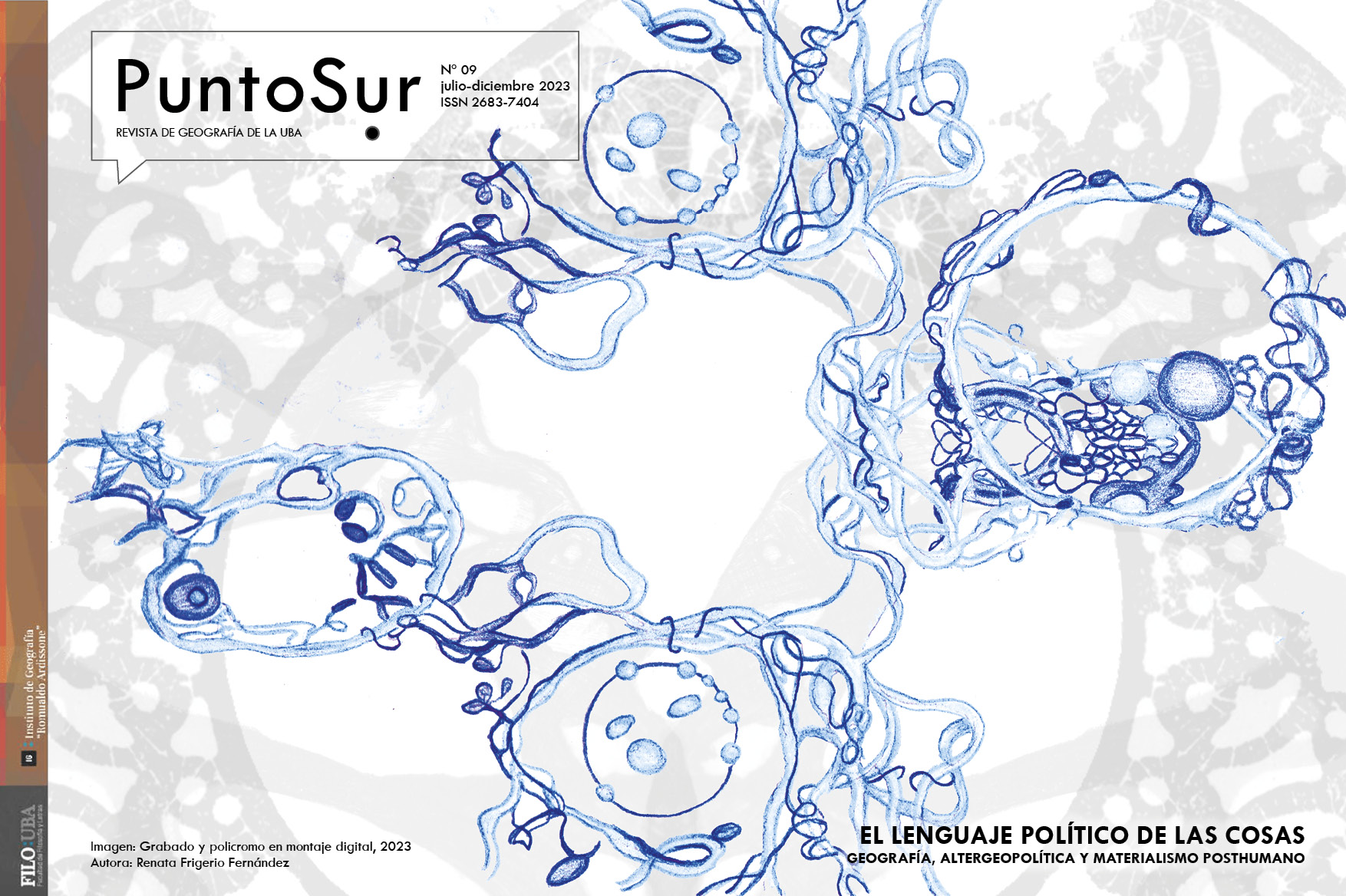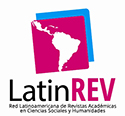Of monsters, ghosts and heroes of "progress". Storytelling for life in Patagonia
Abstract
What are the dangers of telling a single story? What voices and stories are lost in this narrative? It matters what stories we tell in order to narrate with them other stories; it matters what concepts we use in order to think with them other worlds and it matters what images we see, in order to create with them other images. Through the multisituated-multispecies approach and the SF practices of Science Fiction, Situated Feminism, Speculative Fabulation and String Figures, I seek to disassemble and reassemble the entanglement of life storytelling in order to continue together, multiplying the worlds present in the narratives of travelers and explorers who were in the territory of Patagonia in Chile in the nineteenth and first half of the twentieth century and who described its landscape, thus participating in the construction of natural history, a hegemonic narrative. To tell stories for life in Patagonia is to open a story told by heroes of "progress", to give voice and place to those monstrous and phantasmagoric existences that live and die beyond the relationship that separates culture from nature.Downloads
References
Bennett, J. (2022). Materia vibrante: una ecología política de las cosas. Caja Negra Editora. Buenos Aires, Argentina.
Canaparo, C. (2011). El imaginario Patagonia. Ensayo acerca de la concepción conceptual del espacio. Peter Lang editores, Suiza.
Casini, S. (2007). Ficciones de Patagonia: la construcción del sur en la narrativa argentina y chilena. Fondo Editorial Provincial.
Coccia, E. (2021). Metamorfosis. Editorial Cactus. Buenos Aires, Argentina.
Cosgrove, D. (2002). Observando la naturaleza: el paisaje y el sentido europeo de la vista. BAGE, (34).
Cox, G. E. (1863). Viaje en las Rejiones Septentrionales de la Patagonia: 1862-1863. Imprenta Nacional Calle de la Moneda.
Crutzen, P., Stoermer, E. (2000). The Anthropocene. IGBP Newsletter, 41:17–18.
Darwin, C. (1921). Diario del viaje de un naturalista alrededor del mundo en el navío de SM," Beagle" (Traducción de Juan Mateos) (Vol. 1). Calpe.
Darwin, C. (1945). Viaje de un naturalista alrededor del mundo. Disponible en Memoria Chilena, Biblioteca Nacional de Chile. Disponible en: http://www.memoriachilena.gob.cl/602/w3-article-8401.html
Despret, V. (2021). A la salud de los muertos. Relatos de quienes quedan. Cactus.
Fitzroy, R., & García, A. (2013). Viajes del 'Adventure' y el 'Beagle': diario Robert Fitz Roy. CATARATA/CSIC/UNAM/DIBAM.
Gerbi, A. (1960). La disputa del nuevo mundo. Fondo de Cultura Económica.
Gerbi, A. (1978). La naturaleza de las Indias Nuevas: De Cristóbal Colón a Gonzalo Fernández de Oviedo. Fondo de Cultura Económica.
Grasset, J. & Teodoro, M. (2000). Prólogo. En Metafísica y ficción extracientífica. Santiago: Roneo.
Hadfield, M. G., & Haraway, D. J. (2019). The tree snail manifesto. Current Anthropology, 60(S20), S209-S235.
Haraway, D. (1988). “Situated Knowledges: The Science Question in Feminism and the Privilege of Partial Perspective”. Feminist Studies, vol. 14, núm. 3, 575-599.
Haraway, D. (2003). The companion species manifesto: Dogs, people, and significant otherness (Vol. 1, pp. 3-17). Chicago: Prickly Paradigm Press.
Haraway, D. (2013). SF: Science fiction, speculative fabulation, string figures, so far. Ada: A Journal of Gender, New Media, Issue N°3.
Haraway, D. (2015). Anthropocene, Capitalocene, Plantationocene, Chthulucene: making kin. Environmental Humanities 6:159–165.
Haraway, D. (2016). Staying with the trouble: Making kin in the Chthulucene. Duke University Press.
Haraway, D. (2022). Tres mochilas en Colombia. Bolsas para seguir con el problema. En La teoría de la bolsa de la ficción. Rara Avis. Buenos Aires, Argentina.
Haraway, D., Ishikawa, N., Gilbert, S. F., Olwig, K., Tsing, A. L., & Bubandt, N. (2016). Anthropologists are talking–about the Anthropocene. Ethnos, 81(3), 535-564.
Haraway, D., Tsing, A., & Mitman, G. (2019). Reflections on the Plantationocene. Edge Effects Magazine.
Haudricourt, A. y Bardet, M. (2019). El cultivo de los gestos: entre plantas, animales y humanos/ Marie Bardet. Hacer mundos con gestos. Traducido por Pablo Ariel Ires. Buenos Aires: Cactus.
Hudson, W. H. (1893). Idle days in Patagonia. London, Chapman.
K. Le Guin, U. (2022). En La teoría de la bolsa de la ficción. Rara Avis. Buenos Aires, Argentina.
Krenak, A. (2022). Futuro ancestral. São Paulo: Companhia das Letras.
Latour, B. (2017). Facing Gaia. Eight Lectures on the New Climatic Regime. Oxford: Polity Press
Latour, B., Stengers, I., Tsing, A., & Bubandt, N. (2018). Anthropologists are talking–about capitalism, ecology, and apocalypse. Ethnos, 83(3), 587-606.
Margulis, L. (2002). Planeta simbiótico: un nuevo punto de vista sobre la evolución. Debate.
Martinic, M. (2006). Historia de la Región Magallánica. Punta Arenas: Ediciones de la Universidad de Magallanes.
Martinic, M. (2007). Los césares de la Patagonia, ¿otra fuente indígena para la leyenda o una hasta ahora desconocida creación del imaginario Aónikenk? Magallania, 35(2), 7-14.
Meillassoux, Q. (2020). Metafísica y ficción extracientífica. Santiago: Roneo.
Mitchell, W. J. (2008). Imperial landscape. In The Cultural Geography Reader (pp. 177-182). Routledge.
Moore, J. (2016). Anthropocene or Capitalocene? Nature, History, and the Crisis of Capitalism. Oakland: PM Press
Ngozi, C. (2018). El peligro de la historia única. Random House.
Núñez, A., Aliste Almuna, E., Bello, Á., & Osorio, M. (2017). Imaginarios geográficos, prácticas y discursos de frontera: Aisén-Patagonia desde el texto de la nación. Pontificia Universidad Católica de Chile, Instituto de Geografía.
Núñez, A., Galarce, M., & Aliste Almuna, E. (2018). Geografías de lo sublime y el proceso de turistificación en Aysén-Patagonia. Turismo, territorio y poder. En Araucanía-Norpatagonia II, editorial UNRN, Argentina.
Núñez, A., Martínez-Wong, A. y Aliste, E. (2021). La mercancía-espectáculo de las redes sociales: la producción del paisaje edénico y la reserva de vida en Patagonia-Aysén. Revista de Historia, Geografía y Cultura Andina Dialogo Andino, Arica, N°66, p. 53-67.
Pratt, M. (2010). Ojos Imperiales: literatura de viajes y transculturación. Fondo de Cultura Económica.
Said, E. (2018). Cultura e Imperialismo (trad. de Nora Catelli). Debate, Barcelona.
Souriau, É. (2017). Los diferentes modos de existencia. S. Puente (trad.). Editorial Cactus.
Steffen, W., Grinevald, J., Crutzen, P., & McNeill, J. (2011). The Anthropocene: conceptual and historical perspectives. Philosophical Transactions of the Royal Society A: Mathematical, Physical and Engineering Sciences, 369(1938), 842-867.
Strathern, M. (1992). Reproducing the future: essays on anthropology, kinship and the new reproductive technologies. Manchester University Press.
Sundberg, J. (2014). Decolonizing posthumanist geographies. Cultural geographies, 21(1), 33-47.
Swanson, H., Tsing, A. & Bubandt, N. (2015). Less than One but More than Many: Anthropocene as Science Fiction and Scholarship-in-the-making. Environment and Society: Advances in Research, 6:(1):149–166.
Taussig, M. (2009). What Color Is the Sacred. Chicago: The University of Chicago Press.
Tsing, A. (2015). The Mushroom at the End of the World. In The Mushroom at the End of the World. Princeton University Press.
Tsing, A. L., Bubandt, N., Gan, E., & Swanson, H. A. (Eds.). (2017a). Arts of living on a damaged planet: Ghosts and monsters of the Anthropocene. U of Minnesota Press.
Tsing, A. & Carlin, C. (2017b). The best of End Times: A Conversation with Anna Tsing. Edge Effects Magazine.
Tsing, A. L., Mathews, A. S., & Bubandt, N. (2019). Patchy Anthropocene: landscape structure, multispecies history, and the retooling of anthropology: an introduction to supplement 20. Current Anthropology, 60(S20), S186-S197.
Tuan, Y. F. (2007). Topofilia: un estudio de las percepciones, actitudes y valores sobre el entorno. Melusina.
Van Dooren, T. (2014). Flight ways: life at the edge of extinction. New York:Columbia University Press.
Van Dooren, T. (2015). The last snail: loss, hope, and care for the future. InLand andanimal and nonanimal. Anna Sophie Springer and Etienne Turpin, eds.Pp. 1–13. Berlin: Haus der Kulturen der Welt.
Zilio, M. (2022). El libro de las larvas: cómo nos convertimos en nuestras presas. Buenos Aires:
Zusman, P. (2018). Geografías históricas visibles e invisibles, audibles e inaudibles. Diálogos con la Geografía, organizados en el marco del FONDECYT N°1170643: “El discurso de la naturaleza en Patagonia-Aysén: nuevos imaginarios geográficos en la producción del espacio de la nación (1990-2016)”.
Copyright (c) 2023 Ayleen Martínez Wong

This work is licensed under a Creative Commons Attribution 4.0 International License.

 Important notice
Important notice




















